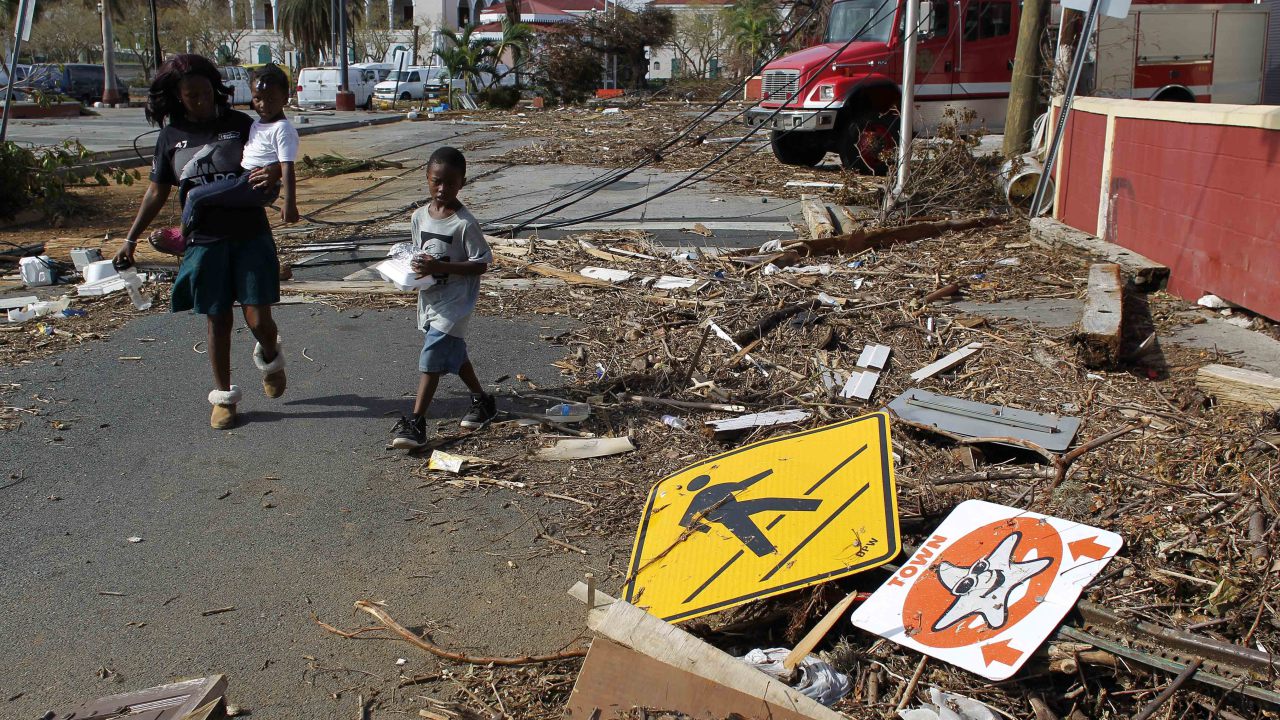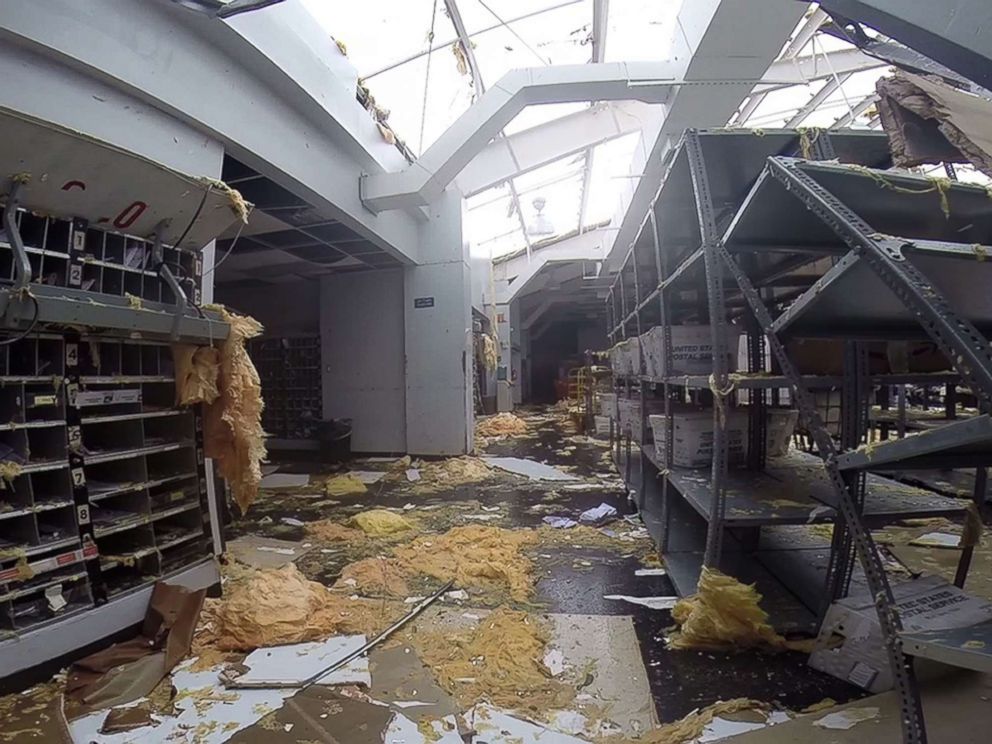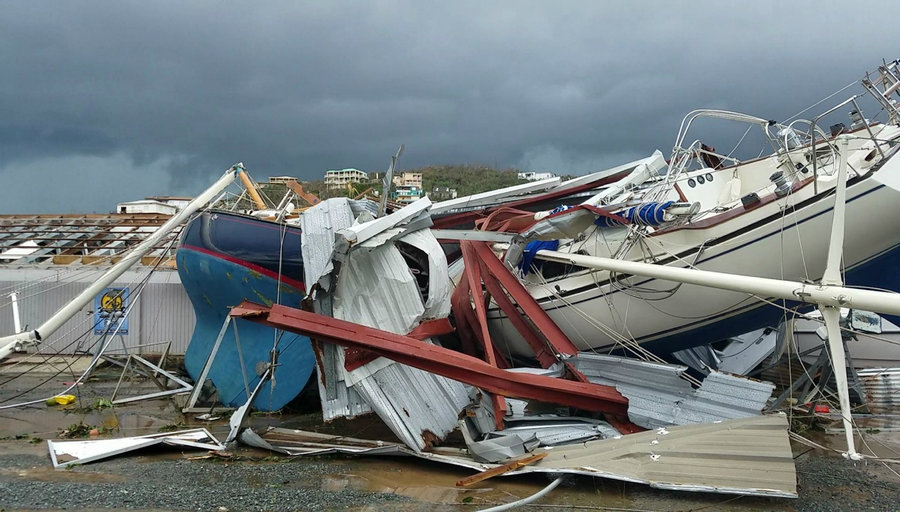 APOCALPYSE NOW: A woman with her two children walk past debris left by Hurricane Irma in Charlotte Amalie, St. Thomas on Sunday, Sept. 10, 2017. (AP Photo/Ricardo Arduengo)
APOCALPYSE NOW: A woman with her two children walk past debris left by Hurricane Irma in Charlotte Amalie, St. Thomas on Sunday, Sept. 10, 2017. (AP Photo/Ricardo Arduengo)
CHARLOTTE AMALIE — Residents of the U.S. and British Virgin Islands have seemingly been left to fend for themselves in the days following Hurricane Irma’s destructive blitz — leaving many feeling uncared for and overlooked.
News coverage relating to Irma — which hit several Caribbean islands as a Category 5 hurricane before striking Florida as a slightly less alarming Category 3 storm — has focused almost entirely on the mainland United States.
Irma’s impact has definitely weighed heavily on the mainland: millions of Floridians have been without power since the hurricane hit, and South Carolina is now grappling with severe flooding.
But elsewhere, a humanitarian disaster has unfolded, one terrifying islanders, many of whom are infuriated by the lack of attention.
“The government is treating us terrible,” U.S. Virgin Islands resident Ureen Smith, 55, told the New York Times.
Smith lived next to a building where one of the four deaths connected to Irma on the islands was reported. She told the Times that resentment towards the U.S. government following the hurricane has grown steadily in the days since the storm made landfall. “Locals are mad they’re not hearing talk about St. Thomas,” she said.
With so much focus on the mainland, residents of places like the Virgin Islands, which is considered U.S. soil but barred from full voting rights, have become increasingly desperate.
About 100,000 people live full-time here, many of whom work in tourism — a precarious industry at the mercy of natural disasters and human interest.
The territory also suffered from financial woes in recent years, borrowing from disaster insurance in order to pay for other needs. Now, residents are contending with a long-term crisis, one heightened by a seeming lack of outside concern.
In the days following the hurricane, islanders have struggled to find fuel, food, and cellular reception. Security has also become an issue, with numerous residents expressing concerns about lawlessness.
Police and fire stations were destroyed, along with medical centers.
A lack of phone service and internet have proven challenging, prompting many to post frantically to Facebook, Twitter, and Instagram when able, begging for help.
“We’re only five days into this, and it feels like it’s been a lifetime,” resident Laura Dixon Strickling told Business Insider on Monday. “We don’t have information. We have not seen one first responder. We have not seen one police officer. Everyone in our neighborhood is walking around with sharpened machetes and guns for protection.”
That description seems to match up with eyewitness reports: footage that circulated following the hurricane revealed the extent of the devastation, with trees uprooted, poles sagging limply, and roads lacking any human presence.
“No power, no running water, no cell service,” said Elizabeth Smith, an island resident who described the aftermath to NPR. “The only hospital on [St. Thomas] faced catastrophic failure during the storm.”
Still, St. John resident Stephanie Stevens emphasized the islanders’ resilience.
“The islanders are prevailing amazingly,” she told the outlet. “Everybody is pitching in, and everybody is pulling out whatever they can — chainsaws, trucks, whatever they can to help get people out of houses, to get people into shelters, to get people food.”
But there was still urgent need for assistance. “We need help,” Stevens added. “We need the United States government to step up. We need military. We need security. We all survived this monster storm. But will we survive the aftermath?”
While assistance from the mainland United States has been slow to take shape, The Trump administration has claimed it is doing everything necessary to care for the survivors. At a briefing on Monday, Homeland Security Adviser Thomas P. Bossert announced that the U.S. military had deployed an aircraft to provide aid to islands devastated by Irma. Secretary of the Interior Ryan Zinke applauded the White House for its efforts in the U.S. Virgin Islands specifically.
“The Department of the Interior actions in the USVI are part of our responsibility for federal policy related to the U.S. territories,” said Zinke in a press release. “We commend the cooperative actions of the White House, USVI government, FEMA and the whole federal family to provide urgent relief to the Virgin Islands.”
As federal assistance slowly makes its way to those affected, some are cautioning that relief efforts could take a long time. The Virgin Islands’ delegate to Congress, Rep. Stacey Plaskett, told MSNBC that the damage to the islands is severe.
“We’ve lost practically 70 percent of our infrastructure in terms of utility system on the island St. Thomas and all of the utility system on the island of St. John,” she said.
That devastation has been a bitter pill to swallow for many islanders — one worsened by a lack of news coverage and general awareness.
“The weather channels didn’t even include us,” said park ranger Laurel Brannick, who lives on St. John. “All they kept saying was that Irma was in the Caribbean and headed to Florida.”
“We’re a small community and we’re destroyed,” she told the Miami Herald. “And it’s not like we can drive to New Jersey and get stuff. We’re an island.”
Matt Gyuraki, a 35-year-old IT specialist, echoed those sentiments.
“It feels like we’re the bastard step-children of America and now nobody wants to help us,” he told the Herald. “America wanted us at one time, but now they really don’t.”

SPECIAL DELIVERY: Hurricane Irma destroyed the U.S. Post Office in Frenchtown.

